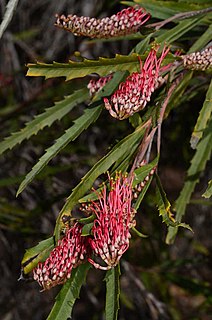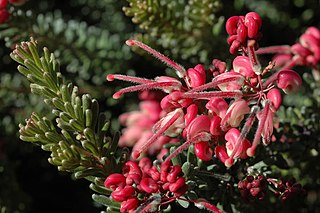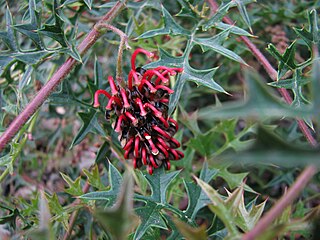
Grevillea longifolia, commonly known as fern-leaf spider flower, is a species of flowering plant in the family Proteaceae and is endemic to the Sydney Basin in New South Wales. It is an erect to spreading shrub with narrowly egg-shaped to almost linear leaves, and toothbrush-like groups of pinkish-fawn flowers with a pink to red style. It is fairly readily grown in gardens.

Grevillea lanigera, commonly known as woolly grevillea, is a species of flowering plant in the family Proteaceae and is endemic to south-eastern continental Australia. It is a spreading shrub with narrowly oblong to more or less linear leaves and clusters of pink to red, and cream-coloured flowers.

Grevillea bipinnatifida, commonly known as fuchsia grevillea, is a species of flowering plant in the family Proteaceae and is endemic to the south-west of Western Australia. It is a spreading shrub, usually with bipinnatifid leaves and loose clusters of dull pink to crimson flowers.

Grevillea crithmifolia is a species of flowering plant in the family Proteaceae and is endemic to the south-west of Western Australia. It is a dense shrub with linear leaves, divided leaves with narrowly oblong lobes, or both, and clusters of pale pink to creamy-white flowers.

Grevillea caleyi, also known as Caley's grevillea, is a species of flowering plant in the family Proteaceae and is endemic to a restricted area of New South Wales. It is an open, spreading shrub with deeply divided leaves with linear lobes, and fawn flowers with a maroon to red style.

Grevillea montis-cole, commonly known as Mount Cole grevillea, is a species of flowering plant in the family Proteaceae and is endemic to central-western Victoria, Australia. It is a shrub with divided leaves with 5 to 15 lobes, the end lobes more or less triangular to narrowly oblong and sharply-pointed, and clusters of greenish to fawn and dull purplish flowers.

Grevillea agrifolia, the blue grevillea, is a species of flowering plant in the family Proteaceae and is native to the north of Western Australia and parts of the Northern Territory. It is a shrub or tree with narrowly oblong leaves with the narrower end towards the base, and creamy-yellow flowers.

Grevillea ilicifolia, commonly known as holly grevillea or holly bush, is a species of flowering plant in the family Proteaceae and is endemic to southern continental Australia. It is a spreading to prostrate shrub with holly-like leaves with sharply-pointed triangular to egg-shaped teeth or lobes, and clusters of green to cream-coloured and mauve flowers with a pink to red style.

Grevillea floribunda, commonly known as seven dwarfs grevillea, is a species of flowering plant in the family Proteaceae and is endemic to eastern Australia. It is a spreading shrub with oblong to egg-shaped leaves with the narrower end towards the base and groups of six to twenty flowers covered with rusty brown hairs.
Grevillea kedumbensis is a species of flowering plant in the family Proteaceae and is endemic to a restricted locale in the Great Dividing Range in central New South Wales in Australia. It is a twiggy shrub with narrowly elliptic to egg-shaped leaves with the narrower end towards the base, and clusters of hairy green to cream-coloured flowers.

Grevillea humilis is a species of flowering plant in the family Proteaceae and is endemic to eastern New South Wales. It is an erect to spreading shrub with narrowly elliptic to more or less linear leaves, and pink or white flowers.
Grevillea granulifera is a species of flowering plant in the family Proteaceae and is endemic to eastern New South Wales. It is a shrub with narrowly elliptic leaves and clusters of pinkish-red and creamy-white flowers.
Grevillea divaricata is a species of flowering plant in the family Proteaceae and is endemic to central New South Wales. It is a low shrub with linear leaves and small clusters of flowers on the ends of branchlets. It is only known from the type specimen.

Grevillea fasciculata is a species of flowering plant in the family Proteaceae and is endemic to the south-west of Western Australia. It is a low, often spreading shrub with narrowly elliptic to more or less linear leaves and erect clusters of red and orange or orange and yellow flowers.

Grevillea anethifolia, commonly known as spiny cream spider flower, is a species of flowering plant in the family Proteaceae and is endemic to continental Australia. It is an erect shrub with hairy branchlets, lobed leaves, the lobes sharply pointed, and white to pale yellow or cream-coloured flowers.

Grevillea baxteri, commonly known as the Cape Arid grevillea, is a flowering plant of the family Proteaceae and is endemic to the south-west of Western Australia. It is an erect to spreading shrub with pinnatipartite leaves and greenish to fawn or creamy-orange flowers.
Grevillea cunninghamii is a species of flowering plant in the family Proteaceae and is endemic to the north of Western Australia. It is a shrub with egg-shaped leaves with sharply-pointed teeth on the edges, and clusters of red flowers.

Grevillea manglesioides is a species of flowering plant in the family Proteaceae and is endemic to the south-west of Western Australia. It is a spreading shrub usually with wedge-shaped leaves with lobed ends, and toothbrush-shaped clusters of flowers, the colour varying with subspecies.

Grevillea diffusa is a species of flowering plant in the family Proteaceae and is endemic to the Sydney region of New South Wales. It is a low, compact shrub with elliptic to linear leaves, and dark red, or dark crimson to scarlet and burgundy-coloured flowers.

Grevillea angulata is a species of flowering plant in the family Proteaceae and is endemic to the Top End of the Northern Territory. It is a spreading to erect shrub with pinnatifid or toothed leaves and cream-coloured flowers.
















